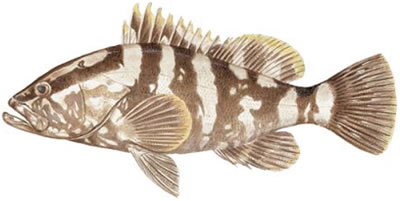The most important commercial grouper in the West Indies and a member of the Serranidae family, the Nassau grouper has been very heavily fished and is continually vulnerable to overfishing, especially during its spawning and migrating seasons.
Identification
Although its color pattern varies, the Nassau grouper usually has a light background, with a wide, dark brown stripe running from the tip of the snout through each eye to the start of the dorsal fin, as well as four to five irregular dark bars running vertically along the sides.
Two distinctive features are the black dots always present around the eyes, and a large black saddle on the caudal peduncle, also always present no matter what color the fish is. The third spine of the dorsal fin is longer than the second, the pelvic fins are shorter than the pectoral fins, and the dorsal fin is notched between the spines. It has the ability to change color, from pale to almost black.
Size
The Nassau grouper is usually 1 to 2 feet in length, reaching a maximum of 4 feet and about 55 pounds, although most catches are under 10 pounds. The all-tackle world record is a 38-pound, 8-ounce Bahamian fish.
Spawning behavior
Spawning around the new moon, Nassau grouper come together in large masses of up to 30,000, making them highly vulnerable to overharvesting.
Food
Nassau grouper feed mainly on fish and crabs and, to a lesser degree, on other crustaceans and mollusks.
Other Names
hamlet; Creole: negue; French: mérou rayé; Spanish: cherna criolla, mero gallina.
Distribution
In the western Atlantic, Nassau grouper are found in Bermuda, Florida, the Bahamas, and the Yucatán Peninsula, and throughout the Caribbean to southern Brazil. They are absent from the Gulf of Mexico, except at Campeche Bay off the coast of Yucatán, at Tortugas, and off Key West.
Habitat
Found in depths of 20 to 100 feet, although almost always dwelling in less than 90 feet of water, Nassau grouper prefer caves and shallow to midrange coral reefs. Smaller fish are usually closer to shore and common in seagrass beds; adults are usually farther offshore on rocky reefs. Nassau grouper tend to rest on the bottom, blending with their surroundings. They are usually solitary and diurnal but occasionally form schools.


